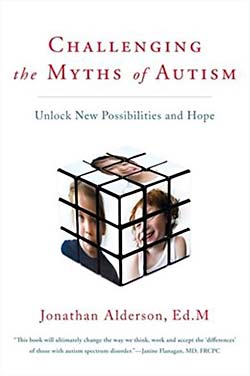Book by Jonathan Alderson, Ed. M.
Review by Cathy Dodge Smith, Ed. D.
Jonathan Alderson presents a refreshing, close look at autism. He points out that many of the beliefs people hold about autism are outdated and need to be re-examined. Each chapter in this book discusses a commonly held belief about autism, and explains why it warrants being reconsidered.
The message in this book is that these misconceptions limit awareness, lower expectations, and can cause parents to lose hope unnecessarily. They also often lead to funding decisions that do not serve children or their families well.
Regarding funding, one myth Alderson exposes is the ‘Five Year Window” myth, which puts forth the position that children lose their chance to change once they turn five. Funding follows this belief so that in North America, Europe, Australia, and other countries, funding for intervention programs is usually restricted to birth through age three, and in a few places up to age six. Alderson provides many examples from his own practice and from research studies to debunk this myth, showing that autistic children continue to learn well after that “magic window”. But for many children, there is no access to intervention programs after the age of five.
Another myth Alderson challenges is the myth of evidence. He flatly rejects the idea held by many that ABA is the only “evidenced-based treatment for autism”. While acknowledging that ABA may be the most-researched treatment method for autism, he makes it clear that there is much good research to support other interventions, and to support the practice of combining approaches.
Alderson strongly rejects the myth that, “Most children with autism have mental retardation”. He cites Ron Davis’ dyslexia correction technique as one that has merit saying, “…I borrowed from a range of sources including some focusing and hand-eye coordination exercises from Ron Davis’ innovative strategies in The Gift of Dyslexia.” [P.164]
Alderson’s many examples bring his thesis to life, and leave the reader with much to think about regarding the potential of people with autism, and implications for treatment. I highly recommend it to anyone who is interested in new ways of thinking about autism.

